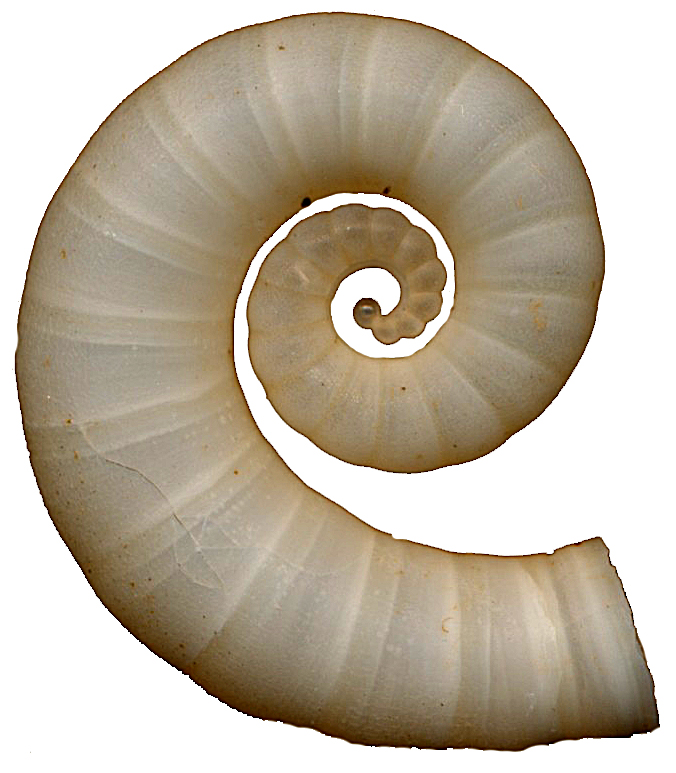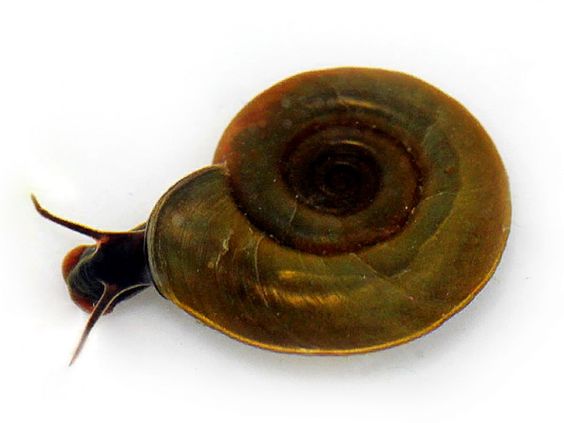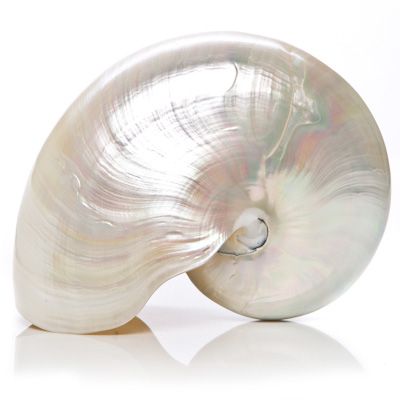EXERCÍCIO 08
EXERCISE 08
Construção de Superfícies complexas a partir da Morfogénese de Cefalópodes
Tendo em conta que a forma geométrica de cada uma destas conchas é definida por meio de duas diretrizes planas (espirais concêntricas) e por geratrizes definidas por círculos existentes em planos perpendiculares ao plano que contém as directrizes.
Construction of Complex Surfaces from Cephalopod Morphogenesis
Bearing in mind that the geometric shape of each of these shells is defined by means of two plane guidelines (concentric spirals) and by generatrixes defined by circles existing in planes perpendicular to the plane containing the guidelines.
EX08.1 Morfogénese: Spirula
EX08.2 Morfogénese: Planorbis
EX08.3 Morfogénese: Nautilus
EX08.1 Morphogenesis: Spirula
EX08.2 Morphogenesis: Planorbis
EX08.3 Morphogenesis: Nautilus



EX08.1 Morfogénese: Spirula
In the case of Spirula, it is known that:
- ◆ the circumference that surrounds the entire geometry has a radius of 15 units;
- ◆ point O corresponds to the center of the previous figure and point A to its right quadrant;
- ◆ a vertical axis with 10 units passes through point O, in the center of the previous figure, whose top is point P;
- ◆ the outer spiral has its center at point O and its largest radius at point A (15 units);
- ◆ the inner spiral is also centered at O and the largest radius is equal to 10 units (its extreme is point B);
- ◆ the number of turns of both spirals is equal to 2 and they both develop clockwise (from the center to the outside);
- ◆ the generatrix is defined by a vertical circle whose diameter passes through points A and B.
EX08.1 Morfogénese: Spirula
No caso da Spirula, sabe-se que:
- a circunferência que envolve toda a geometria tem um raio igual a 15 unidades;
- o ponto O corresponde ao centro da figura anterior e o ponto A ao seu quadrante direito;
- pelo ponto O, no centro da figura anterior, passa um eixo vertical com 10 unidades, cujo topo é o ponto P;
- a espiral exterior tem centro no ponto O e raio maior no ponto A (15 unidades);
- a espiral interior tem centro também em O e o raio maior é igual a 10 unidades (o seu extremo é o ponto B);
- o número de voltas de ambas as espirais é igual a 2 e ambas se desenvolvem no sentido horário (do centro para o exterior);
- a geratriz é definida por uma circunferência vertical, cujo diâmetro passa pelos pontos A e B.


EX08.2 Morfogénese: Planorbis
No caso do Planorbis, sabe-se que:
- a circunferência que envolve toda a geometria tem um raio igual a 15 unidades;
- o ponto O corresponde ao centro da figura anterior, o ponto A ao seu quadrante direito e ponto H ao seu quadrante esquerdo;
- pelo ponto O, passa um eixo vertical com 10 unidades, cujo topo é o ponto P;
- para se construir a espiral que irá servir de base à morfogénese da concha é necessário fazer 4 construções auxiliares
- fase I
- desenhar quatro circunferências verticais cujos diâmetros são respectivamente 1, 2, 4 e 8 unidades;
- estes círculos são desenhados, partindo do ponto O até terminar no ponto A e os seus quadrantes são coincidentes entre si;
- estas circunferências fazem parte das geratrizes que definem a forma final;
- fase ii
- desenhar mais três circunferências verticaiscujos diâmetros são respectivamente 1,5 ; 3,0; e 6,0 unidades;
- estes círculos são desenhados, partindo do ponto O para o ponto H e os seus quadrantes também são coincidentes entre si;
- estas circunferências fazem parte das geratrizes que definem a forma final;
- fase III
- defina o pontos B como o quadrante do lado esquerdo do círculo de 6 unidades de diâmetro;
- defina os pontos D, F para os quadrantes que se intersectam na fase II;
- defina os pontos G, E, C para os quadrantes que se intersectam na fase I;
- desenhe vários círculos planos segundo pontos do seu diâmetro (AB, BC, CD, DE, EF, FG e GO);
- fase IV
- desenhe uma linha de H a A
- corte os círculos definidos na fase III pela linha da fase IV, eliminando a parte do quadrante inferior dos círculos AB, CD, EF e GO, e a parte do quadrante superior dos círculos BC, DE e FG.
- os segmentos resultantes dos cortes definidos anteriormente são as directrizes para o planorbis.
EX08.2 Morphogenesis: Planorbis
In the case of Planorbis, it is known that:
- ◆ the circumference that surrounds the entire geometry has a radius of 15 units;
- ◆ point O corresponds to the center of the previous figure, point A to its right quadrant and point H to its left quadrant;
- ◆ a vertical axis with 10 units passes through point O, the top of which is point P;
- ◆ to build the spiral that will serve as the basis for the morphogenesis of the shell, it is necessary to make 4 auxiliary constructions
- ⁃ phase I
- ⁃ draw four vertical circles whose diameters are respectively 1, 2, 4 and 8 units;
- ⁃ these circles are drawn, starting from point O until ending at point A and their quadrants are coincident with each other;
- ⁃ these circles are part of the generatrices that define the final shape;
- ⁃ phase II
- ⁃ draw three more vertical circles whose diameters are respectively 1.5 ; 3.0; and 6.0 units;
- ⁃ these circles are drawn, starting from point O to point H and their quadrants are also coincident with each other;
- ⁃ these circles are part of the generatrices that define the final shape;
- ⁃ phase III
- ⁃ set point B as the quadrant on the left side of the 6-unit diameter circle;
- ⁃ set points D, F for the quadrants that intersect in phase II;
- ⁃ define the points G, E, C for the quadrants that intersect in phase I;
- ⁃ draw several flat circles according to points of their diameter (AB, BC, CD, DE, EF, FG and GO);
- ⁃ phase IV
- ⁃ draw a line from H to A
- ◆ cut the circles defined in phase III by the phase IV line, eliminating the lower quadrant part of circles AB, CD, EF and GO, and the upper quadrant part of circles BC, DE and FG.
- ◆ the segments resulting from the cuts defined above are the guidelines for the planorbis.
EX08.3 Morfogénese: Nautilus
No caso da Nautilus, sabe-se que:
- a circunferência que envolve toda a geometria tem um raio igual a 15 unidades;
- o ponto O corresponde ao centro da figura anterior, o ponto A ao seu quadrante direito e ponto H ao seu quadrante esquerdo;
- pelo ponto O, passa um eixo vertical com 10 unidades, cujo topo é o ponto P;
- a espiral directriz é igual ao do exercício 1.2
- as geratrizes são círculos verticais definidos segundo dois pontos que contêm o respectivo diâmetro
- serão utilizadas 4 geratrizes, que têm em comum o ponto O e cujo diâmetro é respetivamente de 1, 3, 7 e 15 unidades;
- a segunda espiral directriz é definida através dos pontos do quadrante superior das 4 geratrizes e pelo ponto O.
EX08.3 Morphogenesis: Nautilus
In the case of Nautilus, it is known that:
- ◆ the circumference that surrounds the entire geometry has a radius of 15 units;
- ◆ point O corresponds to the center of the previous figure, point A to its right quadrant and point H to its left quadrant;
- ◆ a vertical axis with 10 units passes through point O, the top of which is point P;
- ◆ the guide spiral is the same as in exercise 1.2
- ◆ the generatrices are vertical circles defined according to two points that contain the respective diameter
- ◆ 4 generatrices will be used, which have point O in common and whose diameter is respectively 1, 3, 7 and 15 units;
- ◆ the second directive spiral is defined through the points of the upper quadrant of the 4 generatrices and the point O.


